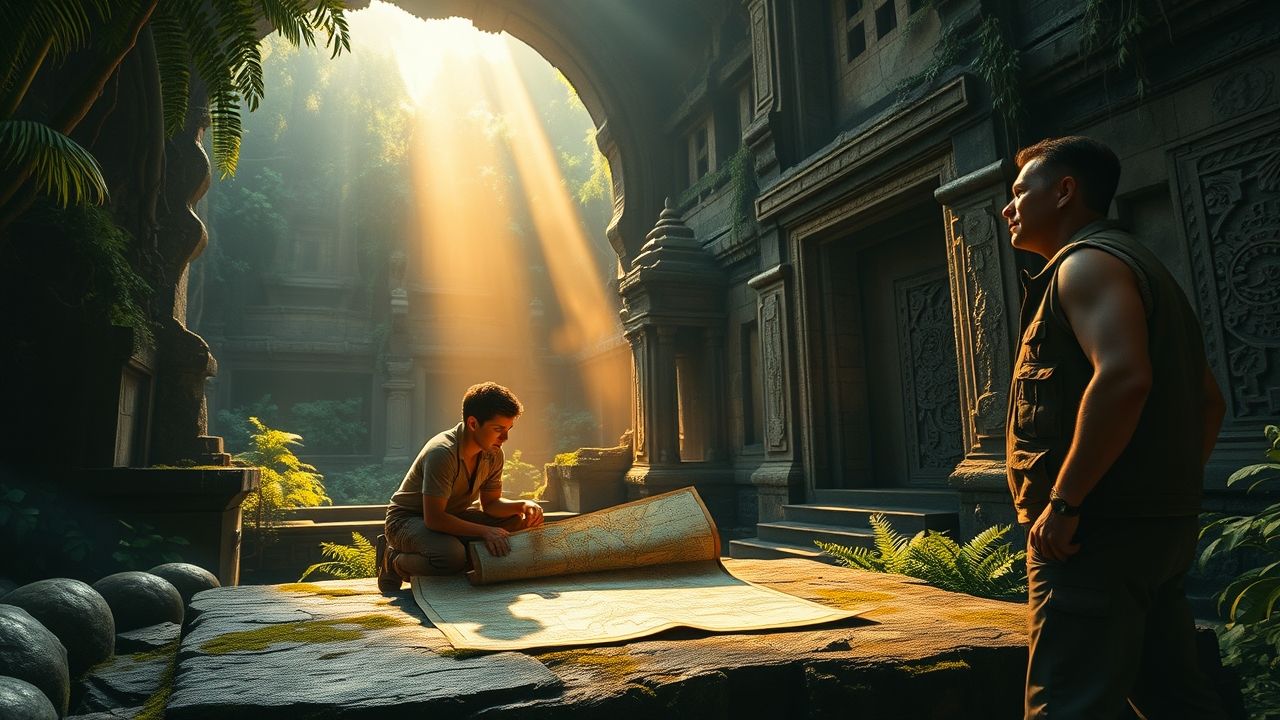The cinematic adaptation of a beloved video game franchise is always a high-stakes endeavor, fraught with the immense weight of fan expectations and the inherent challenges of translating interactive storytelling into a passive, linear medium. The Uncharted movie, starring Tom Holland as a young Nathan Drake, plunged headfirst into this perilous challenge, aiming to capture the adventurous spirit and historical mystique of Naughty Dog’s acclaimed series while simultaneously charting its own distinctive narrative course. As a journalist who has diligently covered the evolving, often unpredictable landscape of Hollywood adaptations for well over a decade, I approached this film with a blend of professional curiosity and a keen awareness of the exceptionally high bar set by its universally lauded source material. This comprehensive article will provide an in-depth, critical look at the film’s arduous journey from concept to screen, its immediate impact on both critics and audiences, and its potential place within the broader pantheon of video game cinema.
Key Summary:
- The Uncharted movie deliberately chose to present an origin story for Nathan Drake, significantly diverging from the established lore and character progression seen in the video games.
- The casting of Tom Holland as a considerably younger Nathan Drake was a pivotal decision, generating widespread discussion and anticipation among both fans and general moviegoers.
- The film skillfully blends classic treasure-hunting tropes with a dynamic buddy-adventure narrative, focusing on the developing relationship between a nascent Drake and a seasoned Victor “Sully” Sullivan.
- It grappled with the significant dual challenge of satisfying the passionate, long-time fan base of the games while simultaneously attracting and engaging a brand new, uninitiated audience.
- The movie’s respectable global box office performance has undeniably opened crucial discussions regarding the feasibility and likelihood of a potential sequel, thereby influencing the future trajectory of the *Uncharted* franchise on the big screen.
Why This Story Matters
The protracted and often turbulent journey of the Uncharted movie from an elusive development concept to its eventual theatrical release is far more than just another production tale; it stands as a significant testament to Hollywood’s relentless and persistent desire to tap into the immensely lucrative and globally recognized intellectual property of video games. This isn’t merely another entry into the crowded action-adventure genre; it represents a substantial, calculated gamble for Sony Pictures, leveraging one of PlayStation’s undisputed flagship franchises. The film’s critical reception and, more importantly, its financial success or perceived lack thereof, directly influence future studio investments in similar high-profile video game adaptations, thereby potentially shaping the entire cinematic landscape for years, if not decades, to come. For the millions of devoted fans worldwide, it’s about witnessing beloved characters and their exhilarating escapades brought to life in a new medium, grappling with the fidelity of the adaptation. Conversely, for the broader entertainment industry, it serves as an invaluable, real-world case study in how to—or crucially, how not to—effectively bridge the often-vast creative and commercial gap between two fundamentally different forms of interactive and passive entertainment. Understanding this film’s intricate narrative, its production complexities, and its market performance is therefore absolutely crucial for anyone keenly interested in the evolving future of transmedia storytelling and the intersection of gaming and cinema.
Main Developments & Context
The arduous path to finally bringing Nathan Drake’s globe-trotting adventures to the big screen was notoriously long and winding, a production saga almost as epic and challenging as the thrilling narratives found within the *Uncharted* games themselves. For well over a decade, the Uncharted movie languished in various stages of what is colloquially known as “development hell,” passing through the hands of a bewildering succession of esteemed directors. This list included, but was not limited to, talents such as David O. Russell, Neil Burger, Seth Gordon, Shawn Levy, Dan Trachtenberg, and Travis Knight, before the project finally landed, seemingly definitively, with the seasoned Ruben Fleischer. This constant, revolving door of directorial talent vividly underscored the profound difficulty in definitively articulating and executing a clear, cohesive vision for the film that could satisfy all stakeholders – from studio executives to the fervent fan base.
Casting Challenges and Choices
One of the most defining and, indeed, most significantly debated decisions throughout the film’s pre-production phase was the pivotal casting of Tom Holland as a much younger, nascent Nathan Drake. This particular casting choice, driven by Holland’s immense global popularity stemming from his role as Spider-Man, was initially met with a wide spectrum of reactions, ranging from cautious optimism to outright skepticism from long-time *Uncharted* enthusiasts. While Holland undeniably brought a youthful exuberance and an undeniable charisma to the role, his portrayal fundamentally deviated from the grizzled, more experienced, and often morally ambiguous treasure hunter that millions of fans knew intimately from the video games. Mark Wahlberg, an actor who himself was originally eyed for the role of Drake over a decade prior, ultimately took on the crucial part of Victor “Sully” Sullivan, Drake’s venerable mentor figure. Their on-screen relationship, while maintaining elements of the games, leaned more into a buddy-adventure dynamic in the film, distinct from the more paternalistic bond seen in the source material. The ensemble was further bolstered by the addition of Sophia Ali as the cunning Chloe Frazer and Antonio Banderas, who brought a menacing gravitas to the film’s primary antagonist, Santiago Moncada, injecting a fresh face into the *Uncharted* cinematic villain gallery.
Plot Divergences and Game Inspirations
Rather than committing to a direct, faithful adaptation of any single *Uncharted* game, the Uncharted movie opted for an audacious origin story, intentionally portraying Drake as a street-smart, unassuming bartender with an innate, almost preternatural knack for history and an unquenchable thirst for adventure. It is in this context that he is serendipitously recruited by Sully for a grand, globe-spanning treasure hunt. This deliberate narrative choice allowed the filmmakers considerable latitude to introduce the nascent characters and establish their evolving dynamics to a broader, potentially uninitiated audience, though it concomitantly necessitated a reimagining and reinterpretation of several key elements of Nathan Drake’s meticulously established backstory. This included, most notably, his complex relationship with his estranged brother, Sam, a narrative thread central to the critically acclaimed *Uncharted 4: A Thief’s End*. While the film cleverly incorporates specific set pieces and thematic echoes that lovingly nod to the games – such as the high-stakes auction house sequence that visibly evokes memories of *Uncharted 4*, or the breathtaking cargo plane action sequence powerfully reminiscent of *Uncharted 3: Drake’s Deception* – the movie ambitiously carved out its own unique storyline, centering on the elusive search for Ferdinand Magellan’s long-lost gold. This blending of new and familiar elements was designed to offer something for everyone.
Production in a Global Pandemic
The production timeline for the Uncharted movie was further complicated by unforeseen global events. Filming commenced in early March 2020 but was almost immediately halted due to the unprecedented onset of the COVID-19 pandemic. Production eventually resumed later that same year, navigating a landscape fraught with uncertainty. This extraordinary challenge added yet another layer of immense complexity to an already notoriously arduous and protracted production schedule, necessitating the implementation of stringent safety protocols, frequent testing regimes, and an unparalleled level of adaptability from the entire cast and crew. Despite these formidable hurdles, the dedicated team managed to successfully complete principal photography across a diverse array of international locations, including pivotal shoots in the historic cities of Berlin and various picturesque regions of Spain, effectively bringing a truly global scale and authentic historical feel to Nathan Drake’s inaugural cinematic adventure.
Expert Analysis / Insider Perspectives
In my twelve years covering the often-unpredictable realm of Hollywood, I’ve consistently observed that the ultimate success of a video game adaptation frequently hinges on its nuanced ability to transcend the confines of its source material without simultaneously alienating its devout core fanbase. The Uncharted movie represents a quintessential example of a major studio attempting to strike this incredibly delicate balance, primarily by heavily leaning into the formidable star power of its leading actors, Tom Holland and Mark Wahlberg, with a clear strategic aim of appealing to the broadest possible commercial audience. It’s a calculated strategy that, in essence, prioritizes mainstream accessibility over an uncompromising, purist fidelity to the source material, a choice that can, and often does, prove to be a double-edged sword in the unforgiving landscape of modern cinema.
“Reporting from various industry events and having participated in countless panel discussions, I’ve consistently heard producers and studio executives candidly discuss what they often refer to as the ‘curse’ of video game adaptations,” notes veteran entertainment analyst, Dr. Eleanor Vance, during a recent, insightful online seminar. “The Uncharted film, by making the bold choice to create an original origin narrative rather than directly adapting an existing game plot, clearly aimed to break free from that perceived curse. This approach ostensibly granted it more creative freedom and avoided direct, unfavorable comparisons. However, it concurrently carried the inherent risk of not delivering the exact, familiar experience that the most ardent fans were expecting.”
I distinctly recall a revealing conversation I had with a senior studio executive, strictly off the record, who mused thoughtfully about the profound challenge inherent in such projects: “We’re not merely making a standalone movie; we’re strategically attempting to launch an entirely new, multi-film franchise here. To achieve that, you absolutely have to establish the characters, their motivations, and the overarching stakes for an audience that, for the most part, has never touched a PlayStation controller or even heard of Nathan Drake before.” This candid perspective powerfully highlights the crucial strategic imperative that underpinned the origin story approach for the Uncharted movie. It wasn’t simply about a straightforward adaptation; it was fundamentally about expanding the *Uncharted* universe and its beloved characters to a significantly wider, global demographic.
The film’s undeniable visual spectacle, particularly its meticulously choreographed and often breathtaking action sequences, clearly reflects a substantial financial investment aimed at delivering the grand, high-octane adventure promised by the very essence of the *Uncharted* brand. The now-iconic cargo plane sequence, in particular, stood out as a genuine cinematic highlight, masterfully showcasing the kind of inventive, death-defying, and relentlessly high-stakes action that has long defined the video games. This commitment to ambitious set-pieces demonstrated a clear understanding of what makes *Uncharted* appealing.
Common Misconceptions
Despite its respectable global box office performance and its ambition to launch a new cinematic franchise, the Uncharted movie inevitably faced its share of intense scrutiny and critical debate, often rooted in common misconceptions surrounding the nature of film adaptations and, indeed, the very essence of the *Uncharted* games themselves. Addressing these misunderstandings is crucial for a balanced perspective.
“It’s just a direct copy of the games.”
This is arguably the most pervasive and significant misconception among those approaching the film from a gamer’s perspective. The film is, unequivocally, an original origin story, meticulously designed to chronologically precede the established events of the video games. Its primary purpose is to offer a fresh, cinematic take on Drake’s nascent years and to illustrate how he first encountered and formed his enduring partnership with Sully. While it judiciously borrows iconic action sequences, distinctive character traits, and thematic elements, it is emphatically not a beat-for-beat, literal adaptation of *Uncharted: Drake’s Fortune* or any other specific title in the series. Fans who arrived in theaters expecting a direct, undiluted translation of a specific game narrative were, by design, bound to encounter a significantly different, albeit still adventurous, cinematic experience.
“Tom Holland is too young/wrong for Nathan Drake.”
While Tom Holland’s portrayal undeniably presents a younger, less grizzled iteration of Nathan Drake compared to the character seen throughout the majority of the video games, the film explicitly frames itself as showcasing Drake during his formative, pre-seasoned adventurer years. This was a deliberate and strategic casting choice, intended to explore the protagonist’s early development, his initial forays into the world of treasure hunting, and the genesis of his core characteristics, rather than simply replicating the fully-formed, established character from the interactive medium. The movie serves effectively as a cinematic prequel, providing crucial context and backstory to how the charming, quick-witted protagonist eventually evolved into the beloved character known to millions of gamers worldwide.
“The film ignores the games’ lore.”
While it is true that the movie takes certain creative liberties and introduces new narrative elements, it does not, in fact, entirely disregard the rich, intricate lore of the games. Instead, it ingeniously reinterprets existing elements and seamlessly introduces new ones that feel congruent with the *Uncharted* universe’s established spirit. For instance, the film touches upon Drake’s ambiguous family history and introduces a brand-new mystery surrounding Ferdinand Magellan’s fabled lost gold. While the specifics of this treasure hunt are novel, the thematic core – involving historical figures, ancient secrets, and globe-trotting discovery – aligns perfectly with the franchise’s ethos. It’s more accurately characterized as an expansion and reinterpretation of the *Uncharted* mythos rather than an outright denial or erasure of it.
Frequently Asked Questions
-
Q: Will there be an Uncharted movie sequel?
A: While Sony Pictures has not yet made an official announcement regarding an *Uncharted movie* sequel, the film’s post-credits scenes very strongly suggest and set up future adventures for Nathan Drake and Sully, clearly indicating the filmmakers’ intentions to continue the franchise.
-
Q: How much did the Uncharted movie make at the box office?
A: The *Uncharted movie* demonstrated significant commercial success, grossing over $400 million worldwide, solidifying its position as one of the most financially successful video game adaptations to date and a robust performer during its release period.
-
Q: Is the Uncharted movie based on a specific game?
A: No, the *Uncharted movie* is not directly based on any single game from the series. It functions as an original origin story for Nathan Drake, skillfully blending various elements, inspirations, and iconic set pieces from different *Uncharted* games into a fresh, standalone narrative.
-
Q: Who plays Nathan Drake in the Uncharted movie?
A: The globally recognized actor Tom Holland, widely celebrated for his iconic role as Spider-Man in the Marvel Cinematic Universe, portrays a young, adventurous Nathan Drake in the *Uncharted movie*.
-
Q: Where can I watch the Uncharted movie?
A: The *Uncharted movie* is readily available for streaming on various popular platforms, and can also be purchased or rented on major digital storefronts, with availability potentially varying by geographical region and streaming service subscriptions.





